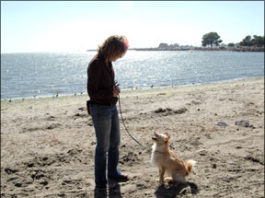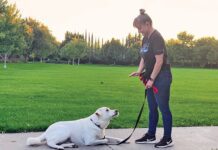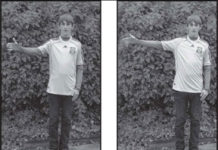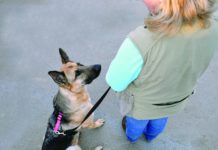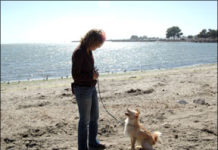Getting Beyond the Basics of Dog Training
Not so very long ago, trainers assumed that anyone who signed up for a basic obedience class was seeking that perfectly straight, sit-in-perfect-heel position. Classes were conducted with military precision, trainers barking commands as owners marched their dogs in a circle, jerking and popping on leashes and choke chains in order to achieve lightning-fast responses. Success was measured by speed and perfection of position, and advanced work was conducted with one goal – to show in American Kennel Club obedience competitions, earn obedience degrees, and achieve scores as close to that magic “perfect 200” as possible.
Dog Training Basics: How to Teach a Cue
While our dogs are born with all sorts of natural canine inclinations – like searching out food, investigating scents, romping with friends – “listen to words from humans” is not part of their default program. With the right kind of teaching, responding to your cues will become a dog’s go-to choice because it is the most reliable route to the things he wants.
Dog Training With Hand Signals
as long as you are consistent.üThis is the gesture I use for cuing "Down!" It's a large signal that can be seen by a dog who is far away.üThis is the gesture I use for cuing "Sit!"I start with my arms at my sides
Shaping Your Dog’s “Sit”
Shaping taking a desired behavior, breaking it into small steps, and reinforcing the steps until you build the final behavior has become a standard dog training tool, especially in the force-free world. Those who are familiar with shaping regard it as invaluable for teaching and refining behaviors. If you don't yet have experience with shaping, try this exercise with your dog. It will help you realize how subtly and precisely you can influence the movement of virtually any part of your dog's body.
The Allure of the Lure
give the cue
Shaping Your Dog’s Behavior
or just the ball on the end of the stick? Do you want her to stand or sit when she touches the ball? Is it okay if she licks the ball or opens her mouth on it? The clearer your vision is
Clean Up Your Cues!
It's important to know what your cues are for your dog. Yes, I bet you think you know, but in reality your dog may think your cues are very different than what you think they are.
Fun Dog Training Techniques Using Shaping!
it doesn't require the dog to figure out for herself what exactly it is that you want.üThis dog is learning to flick a light switch. At first
Advanced Dog Training Methods: How to “Fade” Prompts and Lures
looking right at them
Train Your Dog Using Imitation
owner of The Canine Connection in Chico
Dog Trainers Use of Generalizing a Behavior
But he does it at home!” Usually uttered in a plaintive wail, this common dog owner complaint is often heard in dog training classes, among other places. When one of my students says this, I reassure them that I believe their dog probably does perform the behavior in question with a high degree of reliability in the comfort of his own home. The fact that he won’t do it in class is usually a generalization issue; the owner has only practiced the behavior with her dog at home. He doesn’t know he’s supposed to do it other places. According to authors Mary Burch, PhD, and Jon Bailey, PhD, in their excellent book, How Dogs Learn, “Generalization occurs when behaviors are seen in contexts other than those in which they were originally trained.” Simply stated, this means practicing with your dog in different places, at different times of the day, under different conditions, in the presence of different people, dogs, and a variety of other distractions.
Has Your Dog Training Program Hit a Wall?
If training on your own, consider enrolling in a class or booking a private lesson for one-on-one attention. You aren’t expected to have all the answers yourself. All dogs are different. Even if you’ve trained previous dogs on your own, a little professional guidance might be just what you need to jumpstart success.




